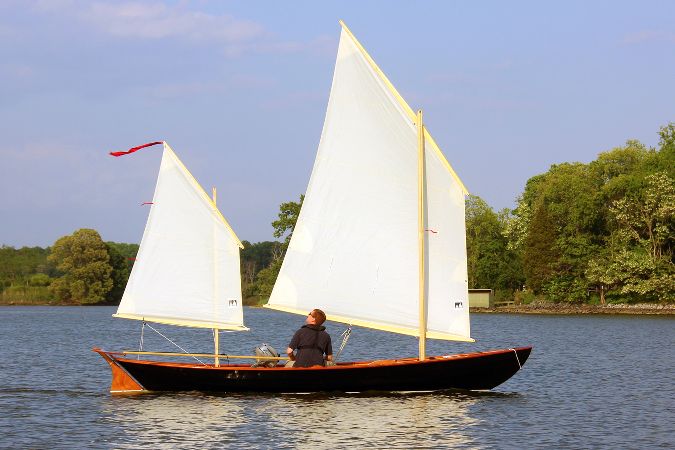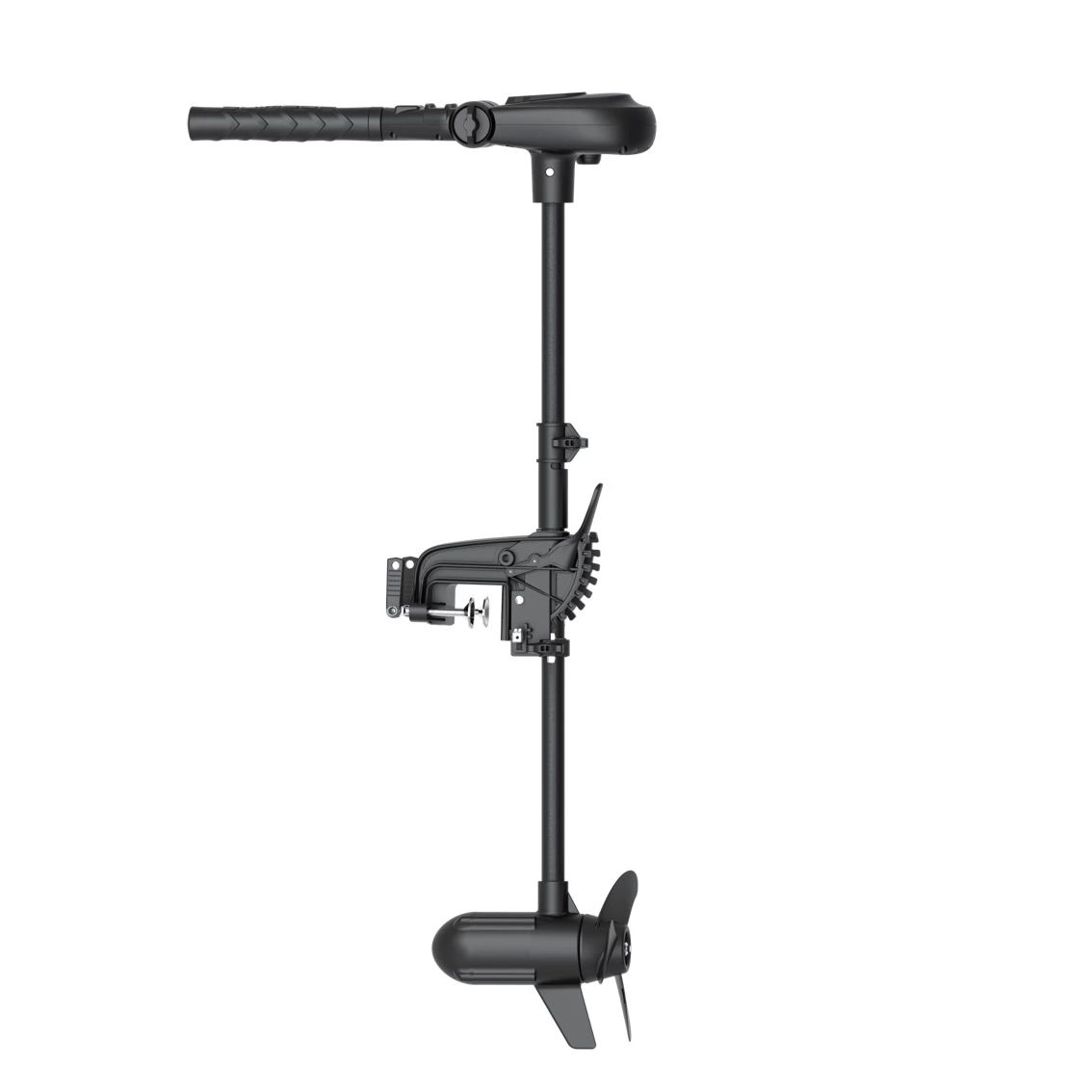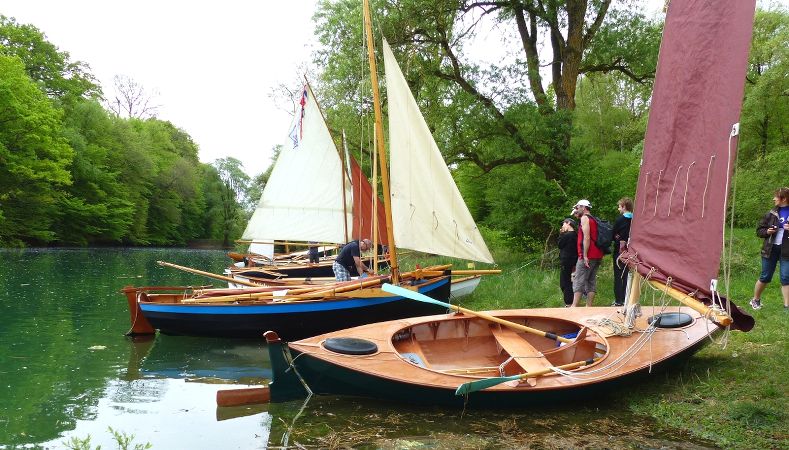




















Product Description
The Southwester Dory is a lightweight and highly capable expedition boat, designed for sailing, rowing and motoring. The sailing rig and motor well are optional, so the boat can be built as a pure motor launch, sailing boat or both. This is an excellent boat for family outings, beach cruising and coastal expeditions.
Based on the proven Northeaster Dory design, the Southwester Dory is extended from 17 feet to 18′ 10″ and the beam increased six inches to 5′ 2″. This provides room for the large built-in buoyancy tanks that have been added to the design, as well as the optional motor well – a frequently-requested modification to the Northeaster Dory, but one which there just isn't space for in the smaller design.
The Southwester Dory's interior is lined with comfortable bench seating along the sides of the boat, with foam-filled buoyancy tanks beneath them making the boat easy to self-rescue from a serious mishap. The large dry storage compartments at the bow and stern will fit over 12 cubic feet of gear, as well as giving the boat even more buoyancy.
The Scandinavian-style push-pull tiller gives you flexibility in seating and makes it easy to turn sharply compared to a conventional tiller of this length. This steering system is a great fit for boats with narrow sterns.
The Southwester Dory is exceptionally versatile. The base kit includes everything you need to make the rowing version of the boat. The sailing rig and outboard well options are modular units that may be added during the build or retro-fitted to an existing Southwester Dory hull.
The bare hull weighs about 200 pounds. A motoring version with engine in place weighs about 280 pounds. Rigged for sail, the hull weight is about 350 pounds. The boat will need a trailer, but the smallest and lightest trailer will be enough.
The Southwester Dory's payload depends on which version you build:
- Base rowing version: 800 lb
- Sailing version (no motor well): 632 lb
- Sailing version (with motor well): 567 lb
- Motoring version (no sailing rig): 667 lb
Motor launch
The stern of a traditional dory is too narrow to mount an outboard motor there, so it is necessary to build a watertight well in the bottom of the boat, about five feet from the stern. This puts the outboard within easy reach of the crew.
From the start, designer John Harris anticipated that many Southwester Dories would be built solely for use as a motor launch. The easily-driven dory hull, with its narrow waterline and fine ends, is suited to small outboards or electric motors. As an ultra-efficient motor launch to cruise rivers, lakes, bays and harbours, the Southwester Dory is a singular good fit. An optional folding bimini top completes the motor launch.
The outboard well will fit a short-shaft (15″) petrol outboard up to the maximum 4 or 5 horsepower. This is not a planing hull, so any more power would just waste effort and payload. A 2 HP outboard is enough to push the boat to hull speed (about 6.5 knots). A 4 HP run just above idle would be very quiet and sip fuel. The outboard may be turned to steer the Southwester Dory, but the boat will turn faster if you use the rudder.
The centreboard is not needed in a motor launch version, opening up a lot more sprawling room in the big cockpit. There is also a simpler alternative rudder for a motor-only Southwester Dory which is shallower and saves the hassle of the kick-up rudder used for the sailing version.
For sailing or beaching, the motor tilts up inside the well. A simple plug seals the well for sailing or rowing performance while the outboard is tilted out of the water.
Sailing
Two balanced lug sails drive the boat easily and with little fuss. Upwind performance is excellent in all conditions and the Scandinavian-style yoke-and-draglink helm is as light as a feather. The boat heels readily but has very strong secondary stability at 10-15 degrees. The ergonomic seating makes it easy for the crew to trim the boat for all conditions. The pivoting centreboard and kick-up rudder make beaching the Southwester Dory easy.
The rig is easy to set up, well-matched to the interior layout and undeniably elegant. Using balanced-lug sails allows solid wooden spars of simple shape and minimal rigging. Expedition crews will rig a boom tent between the two masts and add slats to span port and starboard seats, creating a large sleeping platform for two adults.
The Southwester Dory sails and rows so well that many sailors will leave off the motor well, regaining legroom and payload.
Rowing
Sea trials showed that the Southwester Dory can be rowed all day at a gentle pace and can be rowed upwind even with the sailing rig in place, thanks to its light weight and shallow, easily-driven hull. We recommend 8′ 6″ oars for this boat.
A sliding seat rowing frame could be fitted aft of the centreboard case, though it would get in the way of operating the boat under sail, so it would be something used only on special occasions.
Leave out the sailing components and the motor well and it would be possible to row in tandem; this would actually be a really capable tandem rowing expedition boat. You could even fit tandem sliding seats.
Construction
Construction uses CLC's patented LapStitch™ technique to render a beautiful round-sided clinker hull without a mould or jig or the need for sophisticated joinery skills.
With the considerable interior fit-out, the Southwester Dory is a bigger project than the Northeaster Dory or our smaller sailing and rowing craft. Expect to spend around 250 hours on a sailing version with the motor well option. Kit builders will assemble the planks using puzzle joints, then stitch the hull together with copper wire over four bulkheads and the transom. The frames fit into computer-cut mortises to make sure they are positioned correctly. The entire hull is assembled within a dozen hours of opening the kit boxes.
The hull is reinforced inside and out with fibreglass fabric, then the seats and compartments are fitted and the rails glued on. Broken inwales are optional, but likely to be a popular addition. For durability, everything is sealed in multiple coats of epoxy before finishing with paint and varnish.
Building the Southwester Dory is achievable for patient first-time boatbuilders who have some experience with epoxy and fibreglass, especially if they are building the boat from our pre-cut kit. Construction has been simplified as much as possible without compromising the boat's appearance or function. Most builders will probably have built something smaller like a kayak or a dinghy before taking on this project.
The rowing hull kit includes:
- Pre-cut wooden panels with pre-cut joints, pre-drilled tie holes and panel location marks
- Solid wood parts
- Epoxy resin and activator
- Epoxy fillers
- Copper ties
- Woven glass fabric
- Woven glass tape
- A pair of silicon bronze rowlocks and sockets
- Comprehensive building manual
- Free technical support from a competent builder
In addition to the above, the rowing/motoring hull kit includes the pre-cut plywood and solid wood parts to install a motor well in the Southwester Dory. It includes a rudder specifically for motoring. If the sailing upgrade is also installed, the longer rudder included in the sailing upgrade should be used instead.
Sailing upgrade
A sailing upgrade can be retrospectively fitted to either the rowing or rowing/motoring hull to turn the Southwester Dory into an able sailing boat. The sailing rig can be added to the Dory at any time, even years after the hull is complete. Please note that the base kit (or a completed hull) is needed in addition to the sailing upgrade.
The sailing upgrade includes:
- Lug sails
- Wooden blanks for mast, boom and yard
- Mast step
- Centreboard blank
- Centreboard case
- Rudder blank
- Tiller blank
- Blocks and cleats
The sailing upgrade does not include the warp.
Broken inwales option
Broken inwales add elegance to any boat by mimicking the ends of the ribs in traditional frame-built boats. This option includes everything you need to install broken inwales in the Southwester Dory:
- Pre-cut breasthook and quarter-knees
- Rowlock riser blocks
- Inwales
- Spacer block material
Some trimming and fitting will be necessary. Broken inwales take longer to install because each block has to be carefully positioned and glued in place. Sanding and varnishing are also made more complex. We recommend reading the installation instructions before deciding to install broken inwales.
Plans and manual
These plans and manual contain sufficient information on the cutting of the panels to make it possible to build the boat from scratch. The plans include full size templates for hull panels, bulkheads, thwarts and sailing components. Bulkhead and stitch-hole positions are marked and complete details for the sails and spars are included.
Study manual
This is intended for pre-build study or to help with the decision to purchase. Reading this manual will help you decide whether or not you can build the boat. It is the manual that accompanies the kits. It describes all of the techniques that will be used during the building and also a step by step guide to construction. Scale drawings are used throughout as well as photographs of critical jobs.
If, later, you decide to purchase the kit the cost of this printed manual will be deducted from the kit price.
This does not contain the plans of the panels with the cutting instructions so it is not possible to build the boat from scratch using only this.
PDF study manual
The construction manual for the boat is also available as a PDF download. After credit card authorisation a download link will be sent to the email address put on the order form.
PDF study plans
These study plans are intended to give you an overview of the construction of the boat. They are in PDF format that can be viewed using Adobe Reader. There are two pages and they measure 279 × 216 mm (11″ × 8½″). They can be printed for carrying around.
After credit card authorisation the plans will be sent to the email address put on the order form.






